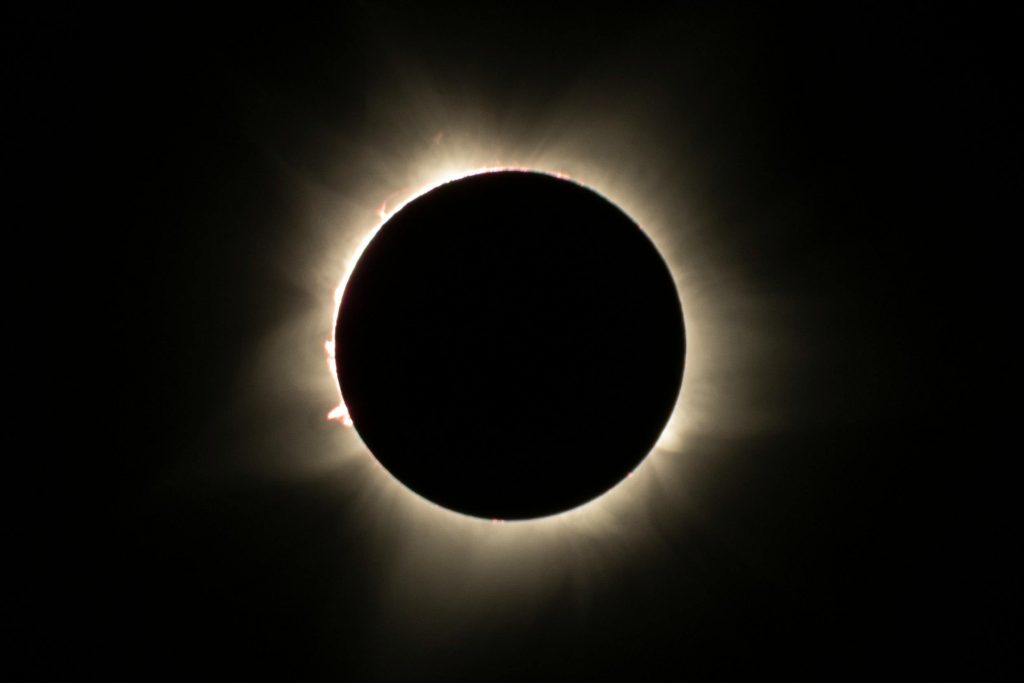
On April 8, 2024, the alignment of the Earth, Moon, and Sun is anticipated to occur, offering a fascinating celestial display that will captivate a global audience and serve as a reminder of the wonders of the universe. This phenomenon is known as the Solar Eclipse.
This article will take you on a trip through time and space as we examine the significance of the impending solar eclipse and the crucial role NASA has played in recording and illuminating its splendor. We will discuss this celestial phenomenon from both science and human interest perspectives, revealing the complex systems at work and the significant consequences for our comprehension of the cosmos.
How Does a Solar Eclipse Work?
The mechanics of the solar eclipse are becoming more and more fascinating as it gets closer. In essence, a solar eclipse happens when the Moon obscures our planet with its shadow as it moves between the Sun and Earth. Because of this alignment, the sky briefly gets darker when the Moon blocks the Sun’s rays, resulting in an amazing display of cosmic geometry. Let’s take a further look into examining this phenomenon’s details to completely understand it.
The Earth’s orbit around the Sun and the Moon’s orbit around the Earth are slightly skewed. As a result, there are occasional times when these three heavenly planets line up exactly to produce an eclipse. During a solar eclipse, the Moon casts two distinct shadows: the umbra, where the Sun is entirely obscured, and the penumbra, where only a portion of the Sun is blocked.
Understanding these intricacies enriches our anticipation of the forthcoming solar eclipse in 2024. Scientists and researchers at NASA have dedicated considerable effort to studying these celestial mechanics, facilitating our comprehension of eclipses and enabling accurate predictions of their occurrences. Their expertise enhances our understanding of eclipse timings, durations, and paths, thus enriching our experience as spectators of this celestial event.
NASA’s Role In Documenting and Discovering
NASA, the well-known space organization that is often associated with exploration and discovery, is essential to our knowledge of the solar system and beyond. NASA contributes much more to solar eclipse research than just observation. Their state-of-the-art equipment and unrelenting commitment to science allow us to observe and understand these celestial events in previously unheard-of detail.
NASA uses an interdisciplinary strategy to research solar eclipses, ranging from the deployment of specialized instrumentation aboard spacecraft to ground-based observations. The Parker Solar Probe is one such mission that goes closer to the Sun than any other spacecraft, offering priceless information on solar dynamics and phenomena. Scientists can learn more about solar activity, space weather, and their possible effects on Earth and space missions by observing the Sun’s corona during eclipses.
Furthermore, the public can actively participate in eclipse viewing because of NASA’s massive outreach programs, which promote scientific awareness and curiosity. NASA welcomes people all over the world to take part in this astronomical show utilizing educational programs, live broadcasts, and interactive materials. This will turn viewers from onlookers into knowledgeable aficionados.
We look to NASA as a light of innovation and exploration as we prepare for the solar eclipse of 2024, helping us unravel the secrets of space and encouraging future generations to dream of traveling to the stars.
Harnessing NASA’s Insights for the Future
Even though the solar eclipse of 2024 is only a brief occurrence, its effects are felt much beyond the brief darkness that covers the planet. NASA’s continuous research and findings during eclipses offer insightful information that is useful for a variety of sectors, including climate science, space exploration, astronomy, and astrophysics.
Through the study of eclipses, scientists can better comprehend the Sun, Earth, and Moon systems and the intricacies of planetary dynamics and celestial mechanics. This information advances wider scientific initiatives as well as our capacity to forecast and analyze the next eclipses. For example, knowledge gained from eclipse observations helps us comprehend exoplanetary systems, where analogous alignments and occurrences take place on far-off worlds.
In addition, NASA’s activities during eclipses act as experimental grounds for novel technologies and techniques, opening the door for creative methods of space exploration and study. These projects push the limits of science and technology, whether they are creating autonomous spacecraft for remote observation or using sophisticated imaging techniques to obtain high-resolution photographs of the Sun’s corona.
The Bottom Line
While we await the 2024 solar eclipse with great anticipation, we are reminded of the close relationship that exists between human curiosity and scientific inquiry. Such rare or infrequent events are a poignant reminder of the continual technological advancements that will provide us with insightful answers to the unknown.
Check out our blog to learn more about science, technology, and how to level up your legacy test equipment!







